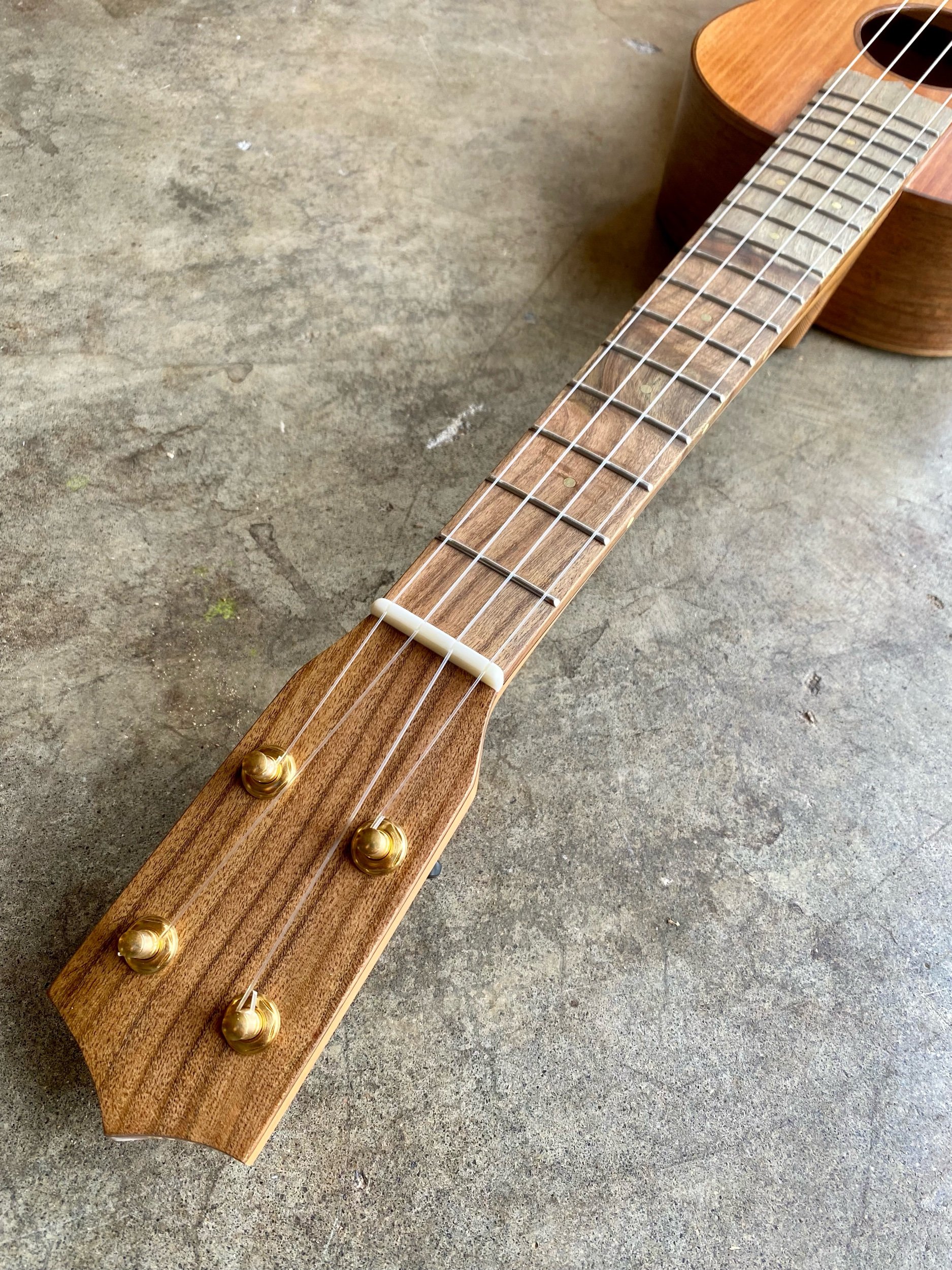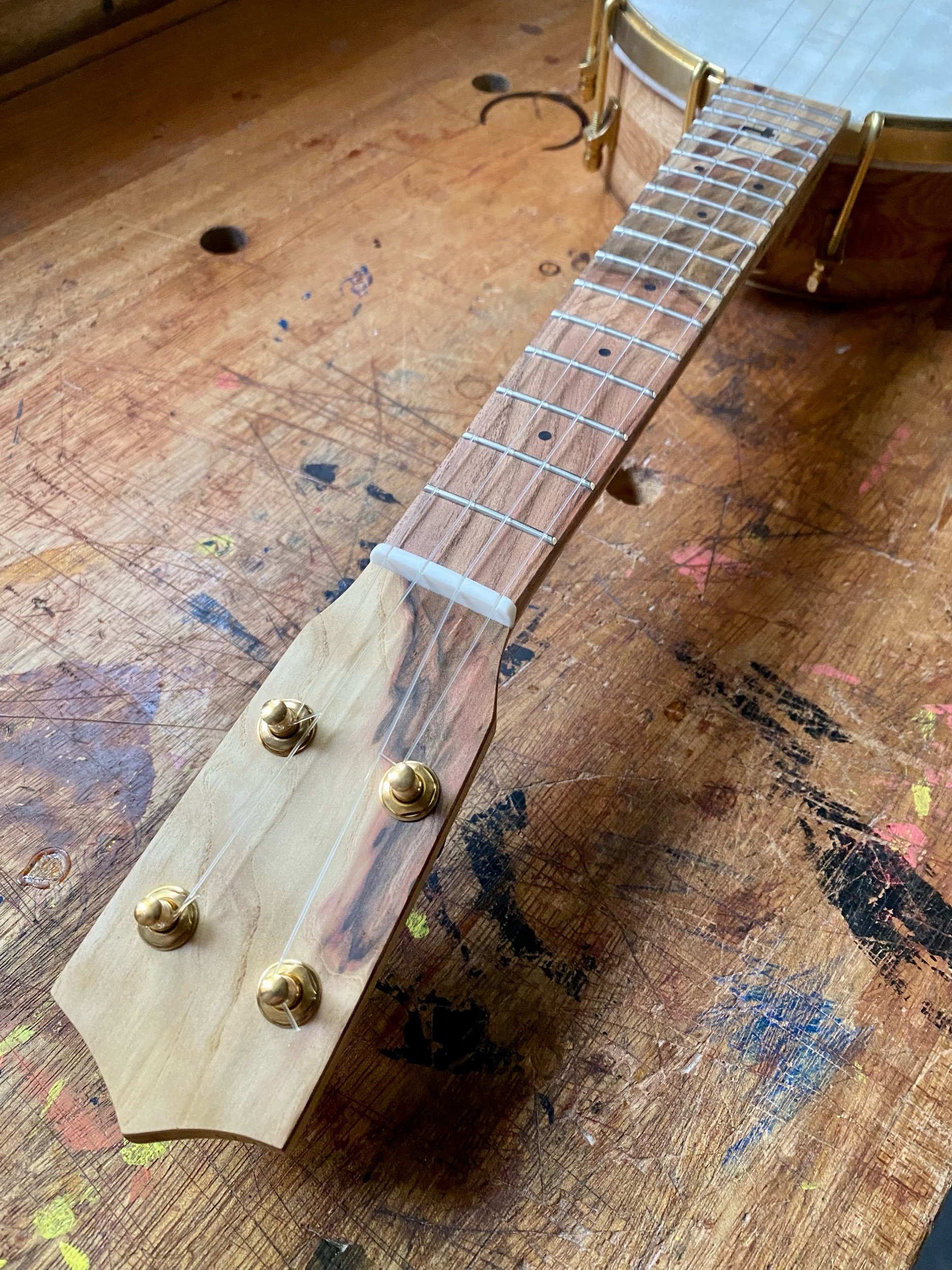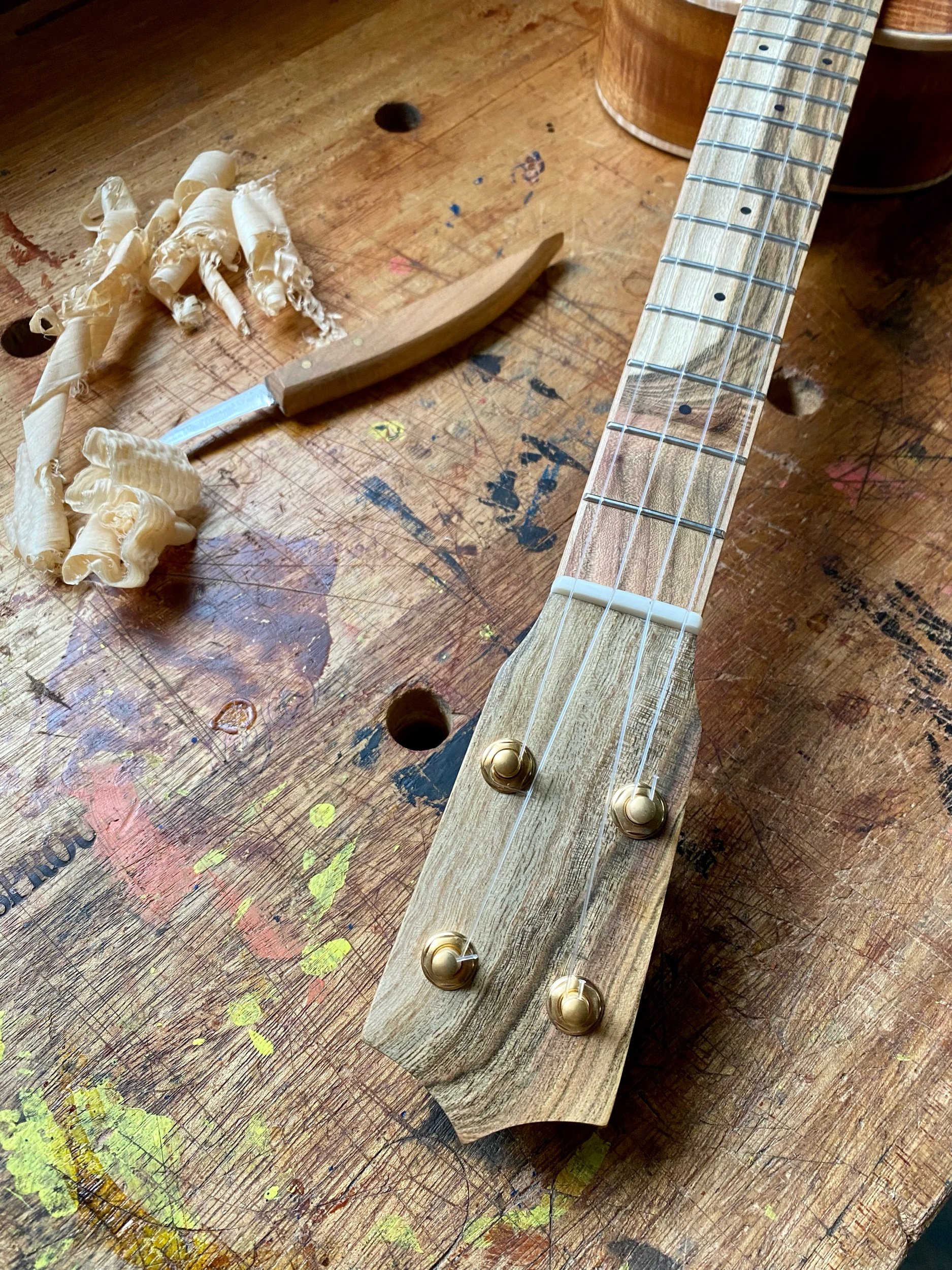White Oak is one of my favorite woods for musical instruments. It looks nice, works easily, is readily available and I love the tone. I think it’s sound has more texture than maple does, a bit gritty or dusty. It is well suited to banjos and ukuleles. This Oak is originally French, salvaged from wine barrels from my neighbors at Hiyu Wine Farm. The Pistachio is from California orchards, harvested when the trees no longer bear fruit. This combo makes for a very sustainable instrument which is closely connected to the food/wine/agriculture industries and makes us feel closer to the region we live in. The Oak pieces show some signs of their last lives as barrel staves, including pieces of oak dowels and some staining from the wine.
#704- Yellow Cedar and Curly Walnut Alto Ukulele
This was a really fun ukulele to put together. A standard model for me, but with lots of tiny details and natural flaws to keep me interested. The Alaskan Yellow Cedar top is from the log we harvested from Camp Westwind, as is the Cedar of Lebanon neck. How that species of cedar made it to Camp Westwind is a mystery to me. The Walnut back and sides is from up the road at The Dee Mill and is the same board as the ukes I’ve built for Dave Matthews recently. Some curly walnut serves as fretboard, headplate and bridge. I bound it with greenish Myrtle and added some bird’s foot purfling to seal the deal. It has a rich but breathy sound and is really fun to play!
#703- Desert Vibes: Juniper and Myrtle Tenor Ukulele
This tenor is a shout-out to three West Coast wood dealers/sawyers with similar values to us: woodfromthewest.com, thedeemill.com and epiloguelumber.com. All three salvage trees that other folks would give up on and turn them into beautiful and useful lumber. Even the scraps are handy to someone like me and these folks keep me well stocked. The Juniper top has a breathy but rich tone, from The Dee Mill. The Myrtle back and sides is from a Portland tree, harvested by Epilogue. The Pistachio fretboard/headplate/bridge is from California orchards from Kevin at woodfromthewest.com.
#694- Port Orford Cedar and Quilted Mahogany Tenor Ukulele
I really appreciate all of the customers, following me on this journey of tradition and innovation. My own mix of old and new is what keeps me excited and this instrument really hits the sweet spot. The back and sides are quilted Mahogany from a classical guitar builder’s estate sale, so is the multi colored “ombré” purfling. The one piece Port Orford Cedar top is from the Oregon coast, via woodfromthewest.com. The Alaskan Yellow Cedar neck was harvested off the beach at Camp Westwind. Everything else is Texas Ebony from a retired banjo builder. I finished it all in amber shellac for an old timey look. But the tone! So rich and smooth, I’m really into it!
“Thank you so much for the wonderful ukulele!
The finish is great. I like the matte look very much. The construction is excellent. The back and sides are excellent and the top grain is perfect. The purfling was a great choice as you said!
String to string very nice and balanced. The pickup sounds great. The tone is excellent. Warm like I would expect with this wood combination. It has a soft warm tone from the cedar.
I am looking forward to it opening up with time. Beautiful instrument I will enjoy for a long time!
- C. G. ”
#705- Port Orford Cedar and Walnut Tenor Ukulele
Another ukulele for Dave Matthews, to match the three I made last year. Port Orford Cedar top from the Oregon coast, local Walnut from The Dee Mill, a salvaged Fir neck and grafted Pistachio California Orchards. The top is stained with tinted shellac and there are big brass fret dots for stage visibility.
#702- Mastergrade Myrtle Soprano Ukulele
Most of my Myrtle comes from Southern Oregon, near the coast. But this tree is from Portland, probably planted as a decorative tree mid 20th century. I got a few boards from the sawyer, https://www.epiloguelumber.com, who specializes in milling urban trees. The grain is wide, but it’s still stiff. The dark markings, curl and figure is fantastic. I have more of it, so just ask and I’ll use it on yours. The neck of this uke is also Myrtle from the same tree. Everything else is Pistachio from woodfromthewest.com.
“Dear Aaron and Nicole-
I love sopranos, and Aaron has knocked it out of the park with this beansprout! The tonality, playability and aesthetics are all superbly executed. It’s truly a wonderful instrument, and I haven’t put it down since it arrived. Thank you for every attention to detail, exemplary customer service, and for bringing joy to so many lives through your crafts. Looking forward to the release of the new clawhammer book as well.
With admiration-
J.K.”
#697- Englemann Spruce and Curly Walnut Alto Ukulele
Louise needed an alto ukulele with a low g, a vibrant sound and easy playability. She has a few specific accommodations for her physical needs, including low action, flat fretboard, low tension strings, thin neck and big white fret markers. Done. The spruce is from a retired guitar maker and the walnut is from Goby in Portland. The Texas ebony is from a retired banjo builder and the spruce for the neck is from my friend Craig. It really sings, I hope it fits her needs!
“#697 is here and I love it. Of course it’s gorgeous, that goes without saying. The headstock is on fire, an amazing surprise for me!
The tone is exactly what I was dreaming of. It’s rich, warm, and at the same time crisp and distinct. Perfect for classical fingerstyle, perfect campanella chimes with great sustain. And I’m getting very noticeable changes of tone depending on where on the fretboard I’m picking. Could not be happier.
It’s a wonderful low-g companion to my beloved high-g Beansprout alto #599. Thank you Aaron for accommodating my flaws and producing these instruments that sing for me.
Love you Keims,
-L. B. ”
#700- Spruce and Curly Myrtle Scout Ukulele
Engleman Spruce from a luthier’s estate sale, curly Myrtle from the scraps of Nicole’s ukulele, a Fir neck from the Carpenter Ant stash and Myrtle fretboard/headplate/bridge from woodfromthewest.com. Sent to a grateful customer in Canada!
#699- Walnut and Pistachio Tenor Banjo Ukulele
A common configuration for me, walnut and pistachio banjo uke, but with two small custom requests: a frailing scoop at the end of the fretboard and a small butterfly inlay on the headstock. The inlay is a new skill that I am working on and it turned out nice, in my opinion. The Walnut is from Vashon island from my friend Cath and the Pistachio is from California Orchards.
#698- Western Red Cedar and Myrtle Alto Ukulele
This is a sweet one. Easy to play, sounds rich and full, feels lightweight but solid and I love the look. Hot tub salvaged Western Red Cedar, Myrtle from the same board as Nicole’s ukulele, Mahogany from the Carpenter Ant stash and Pistachio from California Orchards.
“Hey Aaron, Nicole, and Henry!
We received our Beansprout Alto uke the evening before leaving town on a trip. We only had time to open it up and say WOW…just WOW! The pictures did not do this little gem justice…we are thrilled with how it looks, love all the wood tones and the bird’s foot purfling…Aaron’s excellent craftsmanship shines again!! Since we have been back from vacation and had time to sit down and play, it has fast become our favorite uke. We have eight including the beautiful Beansprout Banjo Uke that y’all made for us in February. As you know all too well, each uke has its own personality, and this one shouts “play me”! It is light as a feather, has a rich and mellow tone for such a little uke, and great sustain too for a small instrument. We love that Aaron put a wound low G string on it. Each note really does ring out like a bell. Hoping one day we can purchase another Beansprout. Thanks again for the caring way you treat your customers. Looking forward to that new Clawhammer Uke book you are working on! :)
-S.M and C.M.”
#695- Curly Walnut and Pistachio Four String Banjo
I love this design. 11” rim and 20” scale, it’s suitable for many tunings and string materials. All kinds of folks have found it useful, which makes me happy. This one is made from Curly Walnut from The Dee Mill and Pistachio from www.woodfromthewest.com. It has a brass tone ring, Renaissance head and a comfortable arm rest.
“Thanks Aaron & Nicole for this beautiful banjo. It arrived today. I’ve been playing it for hours. This will get passed down through the Bastien family for generations to come.
- J. B.
”
#696- Wine Barrel Oak and Pistachio Concert Banjo Ukulele
This beautiful instrument was a nice challenge for me. The customer sent me photos of their favorite beach in Florida, which has a cross on a hill as a landmark. It was fun to pick pistachio and goat skin that wasn’t a literal picture of the beach, but served as the right vibe to invoke it. I inlaid a small ebony cross at the 15th fret to finish it off. The White Oak is from wine barrels I get from my neighbors, Hiyu Wine Farm. It’s French in origin and is beautiful quartersawn material. The Pistachio is harvested from California orchards.
#693- Spruce and Mahogany Scout Ukulele
Spruce top, Mahogany back and sides, Fir neck and Cherry fretboard/headplate/binding. All scraps from other projects. Soprano scale, with geared tuners, strap buttons, bone nut and saddle and fluorocarbon strings. It’s off to the Scout waiting list today.
#675- Juniper and Horse Chestnut Tenor Ukulele
Wow- This one feels so good to play. The whole thing vibrates in the lap and I can tell the sound really sings. This was a collaboration with Chris from The Dee Mill. He dropped off a bunch of scraps over the last couple of years, and I milled and sorted them to be ukulele parts. Many species were new to me, but it was clear what role they could play in an instrument. The top is Juniper from eastern Oregon, which put me in a high desert state of mind, leading me to a color palette and wood layout to fit the vibe. The back, sides and headplate are Horse Chestnut. The neck is salvaged Cypress with a Walnut stripe. The fretboard is Elm, another local wood I had never used. I thought some Walnut would be a good bet for the binding, adding some dark contrast.
Btw, I have more of these woods, drop me a line if you would like a high desert inspired ukulele!
#692- Sycamore Alto Ukulele
Keep it simple. Local wood with sustainable sourcing, easy playability and sweet sound. Sycamore body, Fir and Maple neck and Black Locust fretboard/headplate. The Sycamore is leftover from my time at Mya-Moe and the Black Locust is from up the road at the Dee Mill.
#685- Western Red Cedar and Curly Walnut Alto Ukulele
Cedar and Walnut has been a popular combination lately and I’m not really surprised. It’s local, readily available, looks nice and sounds lovely. Dark, rich, expressive but with a little sparkle to the tone. This alto with a low G doesn’t disappoint. The walnut is from guitar maker Ben Bonham, who passed on these ukulele sized pieces of local timber. I used tiny maple dowels to fill a few bug holes. The cypress neck is salvaged from a factory, complete with knots and a nail hole. Walnut also looks nice as the fretboard and headplate. The cedar comes from an old hot tub!
#689- Port Orford Cedar and Curly Walnut Tenor Ukulele
Classic Beansprout: domestic woods, muted/natural color palette, easy playability and big sound. I love it. The one piece Port Orford Cedar top and Pistachio fretboard/headplate come from our friends at woodfromthewest.com. The curly Walnut back and sides are from luthier Jayson Bowerman and the Spruce neck is from luthier Craig Wilson. Thanks, friends! I love the green Myrtle binding with no black lines, purfling a or veneers, it gives a muted/natural look to the whole thing.
“Hey Aaron and Nicole,
Just wanted to let you know the ukulele arrived safe and sound. I’ve had a few days to play her and she sounds perfect. Great tone, and the radiused fretboard is a treat I’ve never had. Obviously the wood is stunning as well.
Thank you so much for the time and effort put into creating this beautiful instrument. It’s more than I ever dreamed!
- B. T. ”
#687- Curly Mahogany Tenor Guitar
This instrument is based off of an old Regal tenor guitar that my friend Geoff Davis has. I traced it and studied it over a glass of wine a few years ago and I decided to build one. The Regal design is nice because it is balanced, comfortable and confident in its smallness. (Other tenor guitars try to hard to be like their big brothers, I think.)
It’s not really louder than one of my ukuleles, just different. I like this all Mahogany one and I also like them with a spruce top.
The curly Mahogany was scrap from another builder, the Spanish Cedar neck and Texas Ebony fretboard/headplate are from a retired banjo builder. The rope binding and brass fittings seal the deal.
“Aaron, Nichole, and Henry:
I received the instruments yesterday. They are incredible! Thank you for the amazing work you put into these and all your instruments. It is such a joy to play them and I thoroughly enjoy your process and documentation of the builds.
The beautiful woods on the tenor guitar are breathtaking! It looks and sounds so, so good. I’ve got a song I look forward to recording on that guitar in the next few weeks.
I really can’t believe how much life you built into the tone of the soprano uke. You have a real gift, Aaron. Thank you for all that you and your family are doing. You are such a positive contribution to the musical community.
I look forward to many years of enjoying these instruments.
Have a great day,
C.P. ”
#686- Curly Mahogany Soprano Ukulele
This instrument is part of a set with a matching tenor guitar, #687. As always, I’m trying to balance the best of ukulele tradition with my own ideas. This one has a slightly wider fretboard by customer request and I find it very easy to play. The curly Mahogany is from a guitar builders scrap pile and the Spanish Cedar neck and Texas Ebony fretboard are from a retired banjo builder. The sound is warm, but percussive, just what I would want with a soprano.
#690- Mastergrade Koa Tenor Ukulele
Koa is the not the loudest wood, but it has a presence and tone that is always pleasing to me. Maybe it’s just because of it’s history as “the” ukulele wood, the many years we have spent hearing Koa and admiring its beauty. I’ve been playing this one for a few days and have come to appreciate the tone as it “wakes up.”
The Koa from this build came from Notable Woods, where Bruce works hard to produce tonewood from salvaged and renewable sources. The Pistachio fretboard/headplate/bridge are from California orchards. The Mahogany neck was salvaged from a cabinet shop scrap bin.











































































































































